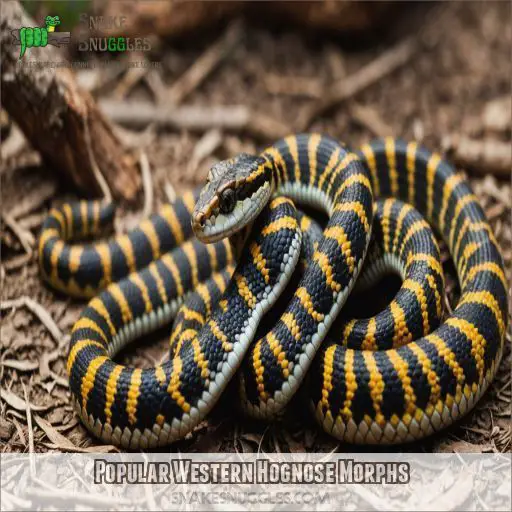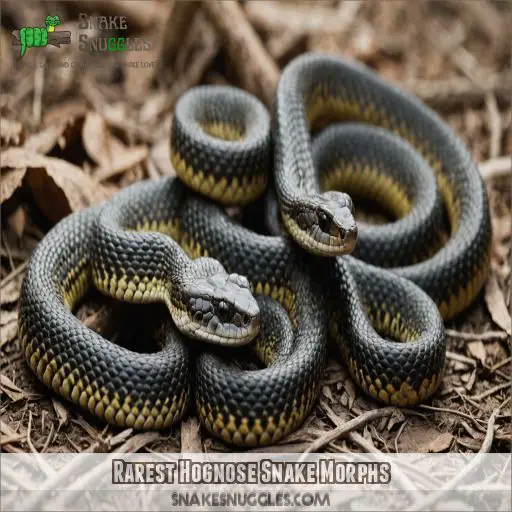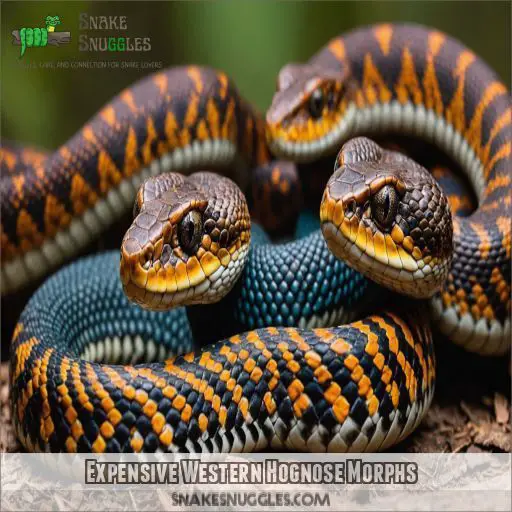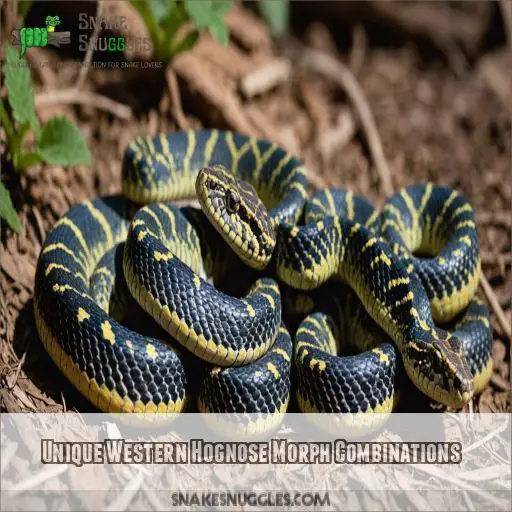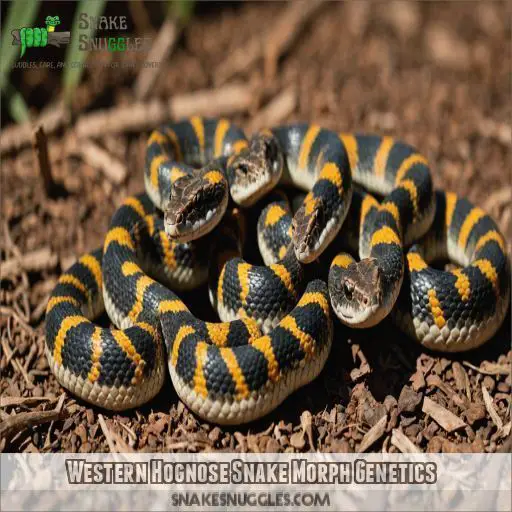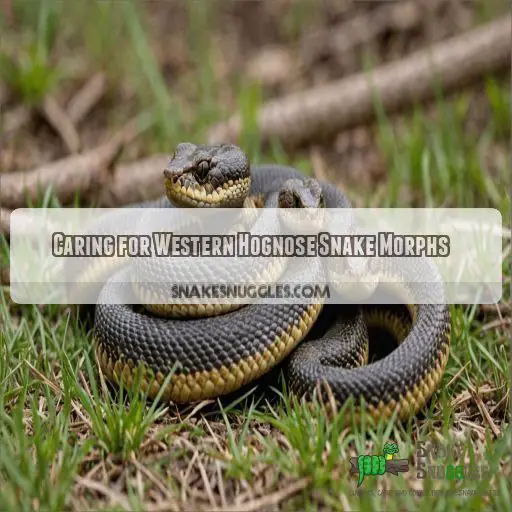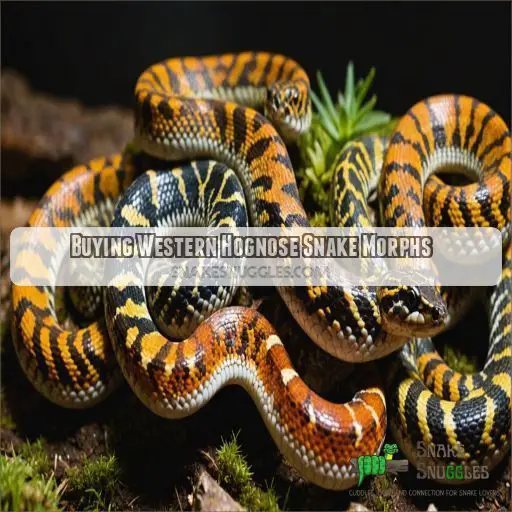This site is supported by our readers. We may earn a commission, at no cost to you, if you purchase through links.
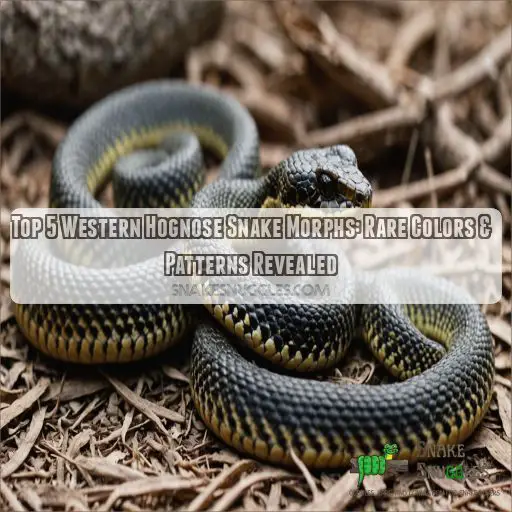 If you’re diving into the colorful world of Western Hognose snakes, you’re in for a treat!
If you’re diving into the colorful world of Western Hognose snakes, you’re in for a treat!
The top 5 Western Hognose snake morphs are sure to make your reptile-loving heart skip a beat.
First up, we’ve got the eye-catching Albino, with its pink eyes and pinkish-white scales.
Next, the Anaconda morph steals the show with its stunning green phase.
The Axanthic morph rocks a striking black and white pattern, while the Caramel morph boasts a rich, golden-brown hue.
Last but not least, the Leucistic morph dazzles with its pearlescent appearance.
But hang on to your snake hooks, folks, there’s a whole rainbow of rare and unique morphs waiting to be discovered!
Table Of Contents
- Key Takeaways
- Popular Western Hognose Morphs
- Rarest Hognose Snake Morphs
- Expensive Western Hognose Morphs
- Unique Western Hognose Morph Combinations
- Western Hognose Snake Morph Genetics
- Caring for Western Hognose Snake Morphs
- Buying Western Hognose Snake Morphs
- Frequently Asked Questions (FAQs)
- What is the most popular hognose morph?
- What is the most expensive hognose morph?
- What are the rarest hognose snake morphs?
- What is a toxic hognose morph?
- How do temperature fluctuations affect Western Hognose morph coloration?
- Can different morphs be housed together safely?
- Do morph-specific health issues exist in Western Hognose snakes?
- How often do new Western Hognose morphs emerge?
- Are certain morphs better suited for beginner snake owners?
- Conclusion
Key Takeaways
- You’ll find a wide variety of Western Hognose morphs to choose from, with the Albino, Anaconda, Axanthic, Caramel, and Leucistic being among the most popular. It’s like a reptilian fashion show, with each morph showcasing its unique colors and patterns!
- Don’t let their dramatic personalities fool you – these snakes are generally easy to care for. You’ll need to set up a cozy, desert-like habitat, feed them every 7-10 days, and handle them gently to keep your scaly friend happy and healthy.
- If you’re interested in rare morphs like the Swiss Chocolate or Pistachio, be prepared for a challenge and a higher price tag. These genetic gems are scarce, but they’re worth the investment for serious collectors.
- When shopping for your dream Hognose, do your research on reputable breeders. It’s not just about finding a snake with a pretty appearance – you’ll want a healthy, well-adjusted animal. A good breeder is like a matchmaker, helping you find your perfect scaly companion!
Popular Western Hognose Morphs
You’re about to enter the fascinating world of Western Hognose snake morphs, where unique colors and patterns will captivate and inspire you. In this article, you’ll discover the top 5 most popular Western Hognose morphs, each with its own distinct characteristics, and get ready to fall in love with these incredible creatures.
Albino Hognose Snake Characteristics
You’re fascinated by the Albino Hognose Snake, one of the most popular Western Hognose morphs. With its striking appearance, it’s no wonder why. But what makes this snake so unique? Let’s break it down:
- Pink eyes and a pinkish-white scales give it an unmistakable look
- Requires specific care, including a controlled environment and diet
- Can be more challenging to breed due to its genetic makeup
- Known for its calm temperament, making it a great pet
- Price range varies, but expect to pay a premium for this rare morph
Anaconda Hognose Snake Traits
You’re in for a treat with the Anaconda Hognose snake!
This morph boasts a stunning green phase with a reverse stripe pattern, making it a fan favorite among breeders and collectors.
Price tags can be steep, but with proper care, these beauties thrive.
Breeding for this color variation requires expertise, so be prepared to do your research and invest in quality.
Axanthic Hognose Snake Features
You’re intrigued by the Axanthic Hognose Snake, and who can blame you? This morph is a stunning result of careful breeding, boasting a unique lack of yellow pigment (Source). Let’s break down its features:
- Coloration: Axanthic Hognoses display a striking black and white pattern.
- Pattern: Their scales show a reduced or altered pattern.
- Care: Provide a warm, humid environment with a balanced diet.
- Breeding: Axanthic Hognoses can be bred with other morphs to create new, exciting variations (Source).
Caramel Hognose Snake Appearance
Now that you’ve met the Axanthic Hognose, let’s talk about the Caramel Hognose Snake‘s appearance.
This morph boasts a rich, golden-brown color with a subtle sheen.
Its pattern is similar to the normal Western Hognose, but with a more muted tone.
The Caramel Hognose is a medium-sized snake.
Its history dates back to the early 2000s when breeders first discovered this unique color variation.
Leucistic Hognose Snake Coloration
You’re probably curious about the Leucistic Hognose Snake‘s coloration. This morph’s genetic basis creates stunning variations, making each snake unique. Here are some key aspects to keep in mind:
- Reduced melanin results in pale, washed-out colors
- Iridescent sheen gives their scales a pearlescent appearance
- Eyes can range from pale pink to blue
- Pattern and color intensity vary, adding to their visual appeal
Rarest Hognose Snake Morphs
You’re about to enter the exclusive world of the rarest Western Hognose snake morphs, where unique colors and patterns make each snake a one-of-a-kind gem. Get ready to meet the top 5 rarest morphs, including the Swiss Chocolate, Pistachio, and Mocha, and discover what makes them so extraordinary.
Swiss Chocolate Hognose Snake Rarity
You’re now entering the world of the rarest Western Hognose snake morphs! The Swiss Chocolate Hognose is a highly sought-after gem, with its unique, rich brown coloration. Breeding challenges and limited availability contribute to its value, making it a true prize for collectors. Market demand is high, but conservation efforts guarantee this morph’s survival for enthusiasts to cherish.
Pistachio Hognose Snake Limited Availability
You’re on the hunt for the elusive Pistachio Hognose Snake!
With its unique coloration, it’s no wonder this morph is in high demand.
However, be prepared for a challenge: Pistachio Hognose Snake breeders face breeding difficulties, and conservation efforts are necessary to protect this rare morph.
Ethical sourcing is super important, and market value can be steep due to its limited availability.
Mocha Hognose Snake Uniqueness
You’ll be amazed by the Mocha Hognose‘s unique charm.
This rare morph boasts a rich, coffee-like hue that’ll make your heart skip a beat.
It’s not just a pretty face, though – Mochas are notoriously tricky to breed, which explains their eye-watering price tag.
If you’re lucky enough to snag one, be prepared for some special care needs.
They’re like the divas of the snake world!
Other Rare Hognose Morphs
Beyond the Swiss Chocolate, Pistachio, and Mocha morphs, you’ll find a treasure trove of rare Western Hognose beauties.
Think Lavender, Sable, and Ghost morphs – each a genetic masterpiece.
These rarities aren’t just eye-candy; they’re living works of art, showcasing nature’s incredible palette.
Breeding these gems is like hitting the snake lottery, with dedicated enthusiasts working tirelessly to preserve and expand these unique bloodlines.
It’s a colorful world out there!
How to Acquire Rare Hognose Snakes
Looking to get your hands on a rare hognose morph? Your best bet is to network with reputable breeders.
Join online forums and attend reptile expos to make connections.
Keep an eye on specialized online marketplaces, but always verify the seller’s credentials.
Sometimes, private collectors might part with their prized snakes.
Expensive Western Hognose Morphs
You’re about to discover the crème de la crème of Western Hognose snakes – the morphs that’ll make your wallet weep but your heart soar. These top-tier beauties come with hefty price tags, but trust us, their stunning colors and patterns are worth every penny (just don’t tell your bank account we said that).
Price Factors Affecting Hognose Morphs
If you’re thinking about getting a Western Hognose morph, you might be surprised at the price tag.
Rarity plays a huge role – the scarcer the morph, the higher the price tag.
Demand is another key player; if everyone’s clamoring for a particular look, you’ll need deeper pockets.
Lineage matters too – snakes with champion bloodlines fetch premium prices.
Breeding difficulty and current market trends can also send prices soaring.
It’s a wild ride in the morph market!
Designer Morph Combinations and Cost
If you’re thinking about designer morphs, you’re looking at a whole new ball game.
These unique combinations can fetch eye-watering prices, often reaching into the thousands.
Why? It’s all about rarity and demand.
Breeders carefully select traits to create one-of-a-kind snakes that’ll make your jaw drop.
But remember, with great beauty comes great responsibility – these pricey pets require expert care and a hefty investment.
Bloodline and Pedigree Impact on Price
With Western Hognose morphs, bloodline and pedigree can really make a difference in the price.
You’re not just paying for pretty colors; you’re investing in a snake’s genetic background.
A well-documented breeding history can be worth its weight in gold, as it guarantees the morph’s quality and potential.
Think of it like buying a purebred dog—those pedigree papers add some serious value!
Limited Availability and Demand
Beyond bloodlines, the rarity of certain morphs plays a huge role in their price tag.
You’ll find that some Western Hognose varieties are as scarce as hen’s teeth!
Breeding challenges and limited gene pools can make these snakes hard to come by.
Collector interest skyrockets for these unique beauties, driving up demand.
It’s a classic case of supply and demand – when everyone wants a slice of the pie, prices soar!
Tips for Purchasing Expensive Hognose Snakes
When eyeing those pricey hognose beauties, do your homework on breeder reputation first.
Don’t be shy about price negotiation – you might snag a deal!
Always insist on a health guarantee; it’s your safety net.
Factor in shipping costs, as they can bite your wallet.
Explore payment options that work for you.
Unique Western Hognose Morph Combinations
You’re about to discover the fascinating world of unique Western Hognose morph combinations. These eye-catching snakes blend different genetic traits to create stunning patterns and colors you won’t find in nature, making them prized possessions for reptile enthusiasts.
Axanthic Caramel Hognose Snake Combination
Now, let’s turn
Anaconda Albino Hognose Snake Combination
The Anaconda Albino combo is a stunning morph that combines the reduced pattern of Anacondas with the eye-catching albino coloration.
It’s like nature decided to paint a masterpiece on a snake.
Breeding these beauties isn’t for the faint of heart, as both genes are recessive.
Expect to shell out a pretty penny for one, but trust us, it’s worth every cent!
Leucistic Mocha Hognose Snake Combination
- Availability: Rare as hen’s teeth, so be prepared to search far and wide
- Price: Expect to shell out big bucks – these beauties don’t come cheap
- Care: Similar to standard Hognoses, but with extra bragging rights
Other Unique Morph Combinations
Beyond the Leucistic Mocha combo, you’ll find a treasure trove of unique Western Hognose morphs. Let’s explore some eye-catching combinations that’ll make your reptile-loving heart skip a beat:
| Morph Combo | Description |
|---|---|
| Albino Anaconda | Pale yellow with intricate patterns |
| Axanthic Pistachio | Silver-gray with subtle green hues |
| Caramel Swiss Chocolate | Rich brown with creamy highlights |
| Ghost Mocha | Faded coffee-colored beauty |
| Superconda Axanthic | Patternless gray stunner |
These rare beauties showcase the incredible diversity in Hognose genetics. Which one catches your fancy?
Creating Custom Morph Combinations
Ready to become a Western Hognose morph maestro? You can create custom combinations by blending different morphs, but it’s not just about making pretty snakes. Consider these ethical points:
- Genetic diversity: Avoid inbreeding to maintain healthy populations
- Unexpected traits: Some combos might lead to health issues
- Community input: Collaborate with other breeders for insights
Use a morph calculator to predict outcomes, but remember, nature loves surprises! Your unique creation might just be the next big thing in the hognose world.
Western Hognose Snake Morph Genetics
You’re about to unravel the genetic mysteries behind Western Hognose snake morphs. Get ready to explore single-gene, polygenic, and combo-gene morphs, learn the basics of hognose genetics, and discover how to predict offspring using a handy morph calculator.
Single-gene Morphs and Genetics
Now, let’s unravel the mystery of single-gene morphs. These eye-catching snakes result from a single genetic mutation, like hitting the jackpot in the DNA lottery. Breeders often play genetic matchmaker, pairing snakes to produce these stunning variations. Here’s a quick rundown of some popular single-gene morphs:
| Morph | Gene Type | Appearance |
|---|---|---|
| Albino | Recessive | Lack of black pigment |
| Axanthic | Recessive | Lack of red/yellow pigment |
| Caramel | Dominant | Rich, warm brown tones |
Polygenic Morphs and Genetics
Unlike single-gene morphs, polygenic traits in Western Hognose snakes are influenced by multiple genes. This complexity can lead to some fascinating color variations and patterns. As you learn more about hognose genetics, you’ll encounter:
- Subtle shade variations within morphs
- Gradual trait changes over generations
- Unpredictable offspring appearances
- Challenges in predicting inheritance
- Exciting potential for unique combinations
Understanding polygenic inheritance is like solving a colorful puzzle – each piece contributes to the stunning final picture!
Combo-gene Morphs and Genetics
Combo-gene morphs take Western Hognose genetics to a whole new level! You’re not just dealing with single-gene traits anymore; you’re playing genetic Jenga. By combining different morphs, breeders create snakes with stunning, one-of-a-kind appearances. Let’s break down some popular combos:
| Morph Combo | Description | Rarity | Wow Factor |
|---|---|---|---|
| Albino Anaconda | Bright yellow with red eyes | Uncommon | 8/10 |
| Axanthic Caramel | Silver-gray beauty | Rare | 9/10 |
| Tri-color Snow | White with hints of pink | Very Rare | 10/10 |
| Super Arctic | Nearly pure white | Extremely Rare | 11/10 |
Genetic Basics for Hognose Snakes
Now that we’ve covered combo-gene morphs, let’s break down the genetic basics for hognose snakes.
You’ll find that most traits are either recessive or dominant.
Recessive traits need two copies of the gene to show up, while dominant ones only need one.
Some snakes are heterozygous, carrying a hidden gene that might surprise you in breeding.
Understanding these basics is key to exploring the colorful world of hognose morphs!
Predicting Offspring With the Morph Calculator
Now that you’ve got the genetic basics down, it’s time to play matchmaker with your hognose snakes!
The morph calculator is your crystal ball for predicting offspring.
While it’s not 100% accurate (Mother Nature loves surprises), it’s a handy tool for planning your breeding projects.
Just remember, with great power comes great responsibility – ethical breeding is key.
The community’s always here to help if you get stuck!
Caring for Western Hognose Snake Morphs
Caring for Western Hognose snake morphs requires attention to their unique needs, from housing to diet. Whether you’ve got an albino beauty or a rare Swiss chocolate morph, you’ll need to master the essentials of hognose husbandry to keep your scaly friend happy and healthy.
Housing and Environment for Hognose Morphs
You’ll want to set up a cozy home for your hognose morph.
Think of it as creating a mini desert oasis!
Start with a 20-gallon enclosure for adults, lined with aspen shavings or reptile sand.
Keep one end warm (around 90°F) and the other cooler (75-80°F).
Mist lightly to maintain 30-50% humidity.
Add some rocks and branches for your snake to explore and hide under.
Dietary Needs for Western Hognose Snakes
Now that you’ve set up your hognose‘s home, let’s talk grub!
These quirky snakes have a taste for the finer things in life – namely, toads.
But don’t worry, you won’t need to go toad-hunting.
In captivity, they’ll happily chow down on mice.
Aim to feed your hognose every 7-10 days, offering prey about the size of their mid-body width.
Handling and Temperament of Hognose Morphs
Now that you’ve got your hognose’s diet sorted, let’s talk temperament.
These little drama queens are known for their theatrical displays!
While most morphs share similar personalities, individual snakes can vary.
When handling, stay calm and confident.
They might hiss or play dead, but it’s all bark and no bite.
With patience and gentle handling, your hognose will become a docile, curious companion.
Health Concerns for Western Hognose Snakes
While Western Hognose snakes are generally hardy, they’re not immune to health issues.
Keep an eye out for parasites, respiratory problems, and shedding difficulties.
These little drama queens might also face nutritional deficiencies or dehydration if their diet isn’t spot-on.
Recommended Equipment and Supplies
Now that we’ve covered health concerns, let’s talk gear.
You’ll need a spacious enclosure – think cozy apartment, not cramped studio.
For heating, a ceramic heat emitter or heat pad will keep your snake toasty.
Choose a substrate that holds moisture well, like coconut fiber.
Don’t forget a sturdy water bowl and a cool spot for food storage.
With these essentials, your hognose will feel right at home!
Buying Western Hognose Snake Morphs
You’re ready to bring home a stunning Western Hognose snake morph, but where do you start? Let’s explore the ins and outs of purchasing these cool reptiles, from finding trustworthy breeders to understanding shipping terms and selecting the perfect snake for your collection.
Finding Reputable Breeders and Sellers
When it’s time to bring home your dream Western Hognose morph, finding a trustworthy seller is key.
Don’t just jump at the first flashy snake you see!
Start by checking out local breeders – they’re often passionate hobbyists who’ll share a wealth of knowledge.
Online marketplaces can be a goldmine too, but do your homework.
Scour reviews, ask for references, and trust your gut.
Tips for Selecting a Healthy Hognose Snake
Now that you’ve found a reputable breeder, it’s time to pick your perfect hognose!
Don’t just go for looks; there’s more to a healthy snake than meets the eye.
Watch for bright, alert eyes and a round body shape.
A curious flick of the tongue is a good sign too.
Ask about the snake’s age, size, and eating habits.
A well-adjusted hognose should be calm when handled, not overly defensive or hissy.
Understanding Terms of Sale and Shipping
When you’re eyeing that stunning Western Hognose morph, don’t forget to read the fine print!
Shipping costs can sneak up on you like a snake in the grass.
Make sure you’re up to speed on legal requirements – nobody wants their new scaly friend stuck in customs.
Check the return policy (just in case your hognose turns out to be a drama queen), and consider payment options.
Delivery times vary, so patience is key!
Reptile Merchandise for Hognose Snake Care
Now that you’re ready to bring your new hognose home, let’s talk about the essential supplies you’ll need. Putting together the perfect habitat is like creating a cozy apartment for your scaly friend. Here’s a quick rundown of must-have items:
- Secure enclosure (escape artists, beware!)
- Substrate that mimics their natural environment
- Hiding spots for when they’re feeling shy
- Temperature-regulating equipment to keep them comfy
Frequently Asked Questions (FAQs)
What is the most popular hognose morph?
You’ll often find the Albino morph topping popularity charts among hognose enthusiasts. Its striking white and pink coloration catches the eye, making it a favorite for both novice and experienced keepers. It’s a real showstopper!
What is the most expensive hognose morph?
You’ll find the most expensive hognose morph is often the rarest or newest. Prices fluctuate, but morphs like Albino Superconda or Triple Het Albino can fetch eye-watering sums. Keep an eye on breeder listings for the latest trends!
What are the rarest hognose snake morphs?
You’ll find the rarest hognose morphs are often coveted treasures. Lavender, super arctic, and pure white albinos top the list. Don’t forget about triple recessive combos – they’re like winning the snake lottery!
What is a toxic hognose morph?
There’s no such thing as a "toxic" hognose morph. You’re barking up the wrong tree. Hognose snakes aren’t venomous, but they’ve got a trick up their sleeve – mildly toxic saliva that helps subdue prey.
How do temperature fluctuations affect Western Hognose morph coloration?
Temperature swings can make your Western Hognose’s colors pop or fade. Cooler temps often darken their hues, while warmer ones might lighten them up. It’s like your snake’s putting on a mood ring show!
Can different morphs be housed together safely?
You shouldn’t house different morphs together. Western hognose snakes are solitary creatures, and mixing morphs can lead to stress, aggression, or accidental breeding. It’s best to give each snake its own enclosure for their safety and well-being.
Do morph-specific health issues exist in Western Hognose snakes?
You might be surprised to learn that morph-specific health issues do exist in Western Hognose snakes. While rare, certain morphs can face unique challenges. You’ll want to research your chosen morph thoroughly to make sure you’re prepared for any potential concerns.
How often do new Western Hognose morphs emerge?
You’ll find new Western Hognose morphs popping up every few years. Breeders are always experimenting, but it’s not an overnight process. Keep your eyes peeled, and you might spot the next big thing!
Are certain morphs better suited for beginner snake owners?
Beauty is in the eye of the beholder," but some Western Hognose morphs are ideal for novices. You’ll find normal, albino, and anaconda morphs easier to care for. They’re hardier and have simpler needs, perfect for your snake-keeping journey.
Conclusion
Western Hognose snakes are known for their dramatic personalities.
Some might argue that they are too dramatic, but their unique morphs make them truly eye-catching pets.
From the striking Albino to the rare Swiss Chocolate, these snakes offer a rainbow of possibilities for enthusiasts.
As you explore the top 5 Western Hognose snake morphs and beyond, remember that each snake’s personality is as unique as its appearance.
Whether you’re drawn to classic or exotic patterns, there’s a perfect Hognose morph waiting to steal your heart and become your next scaly companion.

